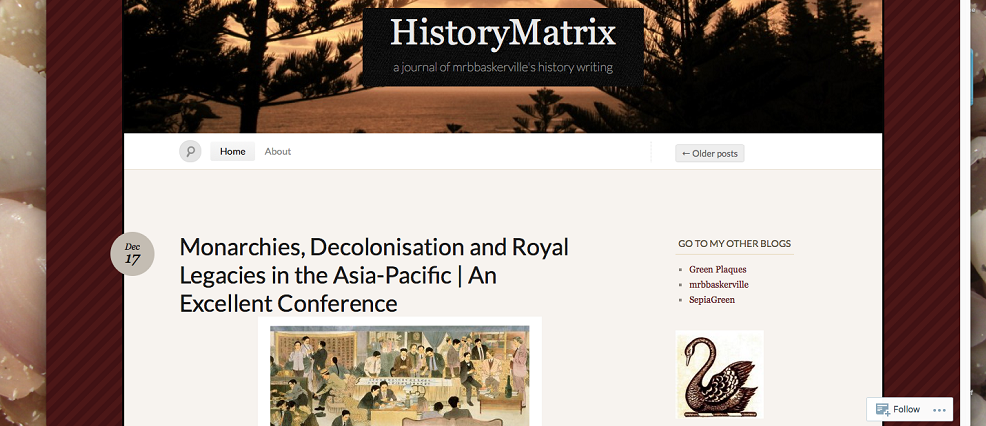…In this occasional series about members’ blogs, we introduce HistoryMatrix, the electronic journal of Dr Bruce Baskerville.
Bruce maintains four blogs – HistoryMatrix is the ‘history’ blog; mrbbaskerville is the place he opines; Sepia Green is a blog for reviews; and, Green Plaques is a grant project to create an archive of commemorative plaques for local communities in the County of Cumberland (Sydney) and larger country towns in New South Wales. He intends adding a fifth, ‘Convict Tracks’, which he is working on with a community group in Western Australia to commemorate the 150th anniversary in 2018 of the landing of the last convict ship at Fremantle.
Bruce learned how to construct and operate a blog (and Facebook and Twitter accounts) at a PHA continuing professional development (CPD) event run by Yvonne Perkins several years ago. He says it has proven to be one of the most useful CPDs he has attended. Any post he does is circulated through Facebook and Twitter, where most comments and feedback are generated. Since November 2014, the blogs have had 24,542 hits. Bruce has 860 followers across all the blogs, which still surprises him a bit! Some posts, especially old walking tour notes, are revisited many times.
One thing Bruce has learnt about blogging: posts need images that have some relationship to the text. He therefore takes lots of photos these days to make sure he has a good stock of images he can use without having any copyright problems. Bruce observes that much academic history remains either uncomprehending or fearful (or both) of using images as an integral part of any history writing not just as occasional decoration.
And that provides the segue to give you a taste of his latest post about a conference he attended in December 2017: Monarchies, Decolonisation and Royal Legacies in the Asia-Pacific | An Excellent Conference. One of his observations about the conference is that visual records such as photographs, a technology that accompanied colonialism, are increasingly available to researchers.
Bruce identifies and discusses five main themes emerging from the papers presented: historiographical biases; change and continuity; power relationships; religious relationships; and, symbolism. The post gives a sense of the scope of work being undertaken on royal history from an Austral-asian perspective and reveals the changing nature of monarchies themselves:
Many papers explicitly or implicitly challenged ideas of monarchies as timeless and unchanging structures. The active insertion by several speakers of temporal dimensions into the study of sovereigns and reigns reinforced perhaps counter-intuitive ideas of royal identities being retained through change, not stasis.
Crowns are engaged in continual processes of re-making and re-imagining, some more effectively than others. This can be seen through the co-option of western trappings of monarchy, especially in Pacific island kingdoms, or the presentation of royals as exemplars of middle class respectability. Another lens was articulated through arguments over whether royal change was a return to original, purer forms of monarchy or a transformation into new democratic institutions; whether ancient rituals were being reinstated in older forms stripped on later accretions, or were rituals being commodified for consumption by newly-wealthy consumer cultures.

Good work Bruce
I am delighted that the CPD helped you start four blogs Bruce! 🙂
I agree about your comments regarding the importance of photos. More and more I have been thinking about how important it is that historians of the 20th and late nineteenth century really need to learn how to ‘read’ photos and take them seriously as historical evidence – not just ‘decoration’ as you say.
Photos are also an important communication device for readers. Historians should not just rely on writing to communicate to readers. Including photos is not ‘dumbing down’ history. Photos are a sophisticated communication medium in their own right, as so many artists and photo-journalists have demonstrated. But adding words with photos brings even more understanding. Each form complements the other in powerful ways.
I agree on importance of visual material. Since Fairfax took over our local paper, they have asked the local societies to supply a pictur e story eac week and it is going well.